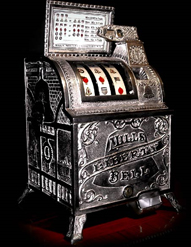Mills Liberty Bell

Sittman and Pitt first developed the gaming machine that would become the precursor to the modern machine in the coming times, in Brooklyn in 1891, in the city of New York.
The evolution of gaming machines has a rich history rooted in innovation and competition. From the inception of the first 'one-armed bandit' by Charles Fey, to the subsequent successes of the Mills Liberty Bell, these machines transformed the gaming landscape. By integrating assembly-line production techniques, the Mills Novelty Company revolutionized the manufacture of slot machines, ensuring their prevalence in entertainment venues. Today's gaming machines have built upon this legacy, incorporating advanced technology and engaging features that attract players worldwide. To learn more about the fascinating journey of gaming machines and their impact on the industry, visit rich-casino.biz.
The origin-the breakthrough invention by Fey
Also called as the 'first-armed-bandit', Fey designed the first machine which paid out automatically, if the player landed with a winning combination. With three reels and not ten cards but five symbols instead, the player would win if we was left with a three bells combination. Owing to its instant success and this bell winning combination, Liberty Bell became the popular term to refer to this machine. The whole notion of gaming using mechanical machines was given a turn with this invention of Fey.
4-11-44 was the name given to what was designed as a result of the Liberty Bell, it's first descendent, again named after the combination that the player had to achieve to win 5 dollars. In 1899, the Card Bell machine came out, invented by Fey, who by now had now a factory production of these machines. A 'star' symbol was included, and the prize, again to be won with the winning combination of three bells was twenty dimes.
From the Liberty Bell to the Mills Liberty Bell
In his quest to gain dominance of the gaming market, Fey didn't quite have much of a trouble with legislatures or competition. As other companies including Monarch started to come up in the market with their own machines, Fey's control was tested, although nobody can comment on the accuracy of the story. It is widely believed that Fey never became willing to sell his Liberty Bell to any buyer, although there is different contrary version of the story According to one theory, the Liberty bell (along with an apron) were stolen in 1905 from a saloon in San Francisco.
The Mills Liberty Bell came out after less than year of this incident; by a company called the 'Mills Novelty Company'. Mills would later be known as Henry Ford of slot machines-as he continued to work, introducing assembly-line techniques, standing the test of time. On the other hand, the other story goes that Charles Fey joined the Mills Novelty Company, and the Mills Liberty Bell was a consequence of this-which was the ultimate thing.
Having the Liberty Bell as a shape in front, the Mills Liberty Bell had a cast iron case, and became a huge success. Ornate scrolled feet replaced the toes made out of cast iron in the earlier version of the machine. When a player hit a combination which was one of the winning combinations, the bell rang. The reel strips displayed the king, jack and the queen playing cards.
